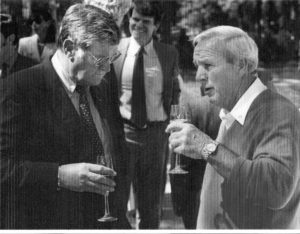Adapted with permission by Patricia Castelli
 Fred Findlay, a Scottish immigrant and renowned designer of several courses in central Virginia, built Keswick Club’s original golf course in 1939. The course, which opened with Findlay’s first nine, expanded to 18 holes in the mid-1950s. The refurbished Keswick Hall follows the same routing as the original 1948 Fred Findlay design, later renovated by Arnold Palmer . The course was redesigned in 1990 by Arnold Palmer (The Arnold Palmer Golf Course Design Company), elevating Keswick to the status of an Arnold Palmer Signature Course. Palmer said the course had “good bones” and was therefore able to keep the majority of the original design. Palmer’s touches included additional bunkers, contouring changes to the land, greens built to United States Golf Association standards, and a new tee-to-green irrigation system.
Fred Findlay, a Scottish immigrant and renowned designer of several courses in central Virginia, built Keswick Club’s original golf course in 1939. The course, which opened with Findlay’s first nine, expanded to 18 holes in the mid-1950s. The refurbished Keswick Hall follows the same routing as the original 1948 Fred Findlay design, later renovated by Arnold Palmer . The course was redesigned in 1990 by Arnold Palmer (The Arnold Palmer Golf Course Design Company), elevating Keswick to the status of an Arnold Palmer Signature Course. Palmer said the course had “good bones” and was therefore able to keep the majority of the original design. Palmer’s touches included additional bunkers, contouring changes to the land, greens built to United States Golf Association standards, and a new tee-to-green irrigation system.
This combination has produced a perfect blend of classical and modern golf course architecture. The lush grounds, old growth trees, shrubs, and sheer beauty will allow one to step back in time while playing a modern and very challenging course. Arnold Palmer has used the wonderful setting of the estate to fashion a course of exceptional natural beauty, featuring tall ancient oaks, grassy wetlands and spectacular mountain views as well as a variety of lakes and streams.
A little history lesson: The resort was originally a private home called “Villa Crawford,” with fireplaces, ornate ceiling molding and a grand staircase. It was built in 1912 as a private residence for Mr. and Mrs. Robert B. Crawford. Robert Crawford, born in Alabama, had been a medical student at the University of Virginia, and his wife came from Providence, R.I., where her father was commodore of the Newport Yacht Club. Designed by prominent local architect Eugene Bradbury, the 8,000-square-foot, two-story, stucco-clad structure originally cost $100,000 to build.
After several subsequent owners led to a state of “senile ruin” with “touches of elegance” remaining, Villa Crawford was purchased in 1990 by Bernard Ashley, the widower of Laura Ashley, the famous textile designer who died in 1985. The new owner saw the potential for a world-class hotel after purchasing the home and 600-acre property for $5.5 million. He had the goal of turning it into a “country house” hotel, and felt strongly that Villa Crawford would be the heart of a truly outstanding property.
Ashley spent $25-million-plus expanding the number of guest rooms to 48, with each individually furnished and decorated. Laura Ashley’s signature style was incorporated into the public spaces as well, and her husband placed many items in the hotel from his personal collection of antiques, including paintings, sideboards, cabinets, sculptures, busts and lithographs.
When it came to building a worldwide design empire on the basis of his fame, Arnold Palmer succeeded like nobody else. Palmer, who died recently at age 87, was a smart-enough businessman to know that his clients would be thrilled even if he were to show up only at the occasional ceremonial event to bless work that was well underway.
He cared enough to monitor progress on the 306 design projects that came his way during the last half-century of his life. He also knew the key was to hire good associates and to entrust and empower them.
Nobody mistook Palmer for the architect. At news conferences and ribbon cuttings, Palmer would defer to his design associates to provide technical details. Such is the confidence when you’re The King.
In the early 1990s when Keswick Club was bought by Lord Bernard Ashley , Ashley hired Arnold Palmer to reconstruct the club’s golf course that had been dormant for years. Palmer rebuilt the course and was there for the grand opening, playing the course before a crowd of about 400 who wanted to get a glimpse of the legendary golfer.
Charlottesville architect Hank Browne, who was overseeing the construction of the hall and club told a great story recalled by Patricia Castelli in her book “The History of Keswick Hall”. Arnold Palmer and Hank Browne were standing behind the Hall admiring the newly seeded and hayed 18th green when they heard the whirr-whirr-whirr of a helicopter in the distance. As it came closer, they realized it was BA (who loved helicopters) and he was coming closer and closer. They watched in disbelief, and AP turned to Hank and said, “He wouldn’t… he wouldn’t…” And then he DID land right on the 18th — seeds and hay scattering everywhere. Arnold Palmer softly said to Hank, “I wonder if he has any idea what that just cost.”


